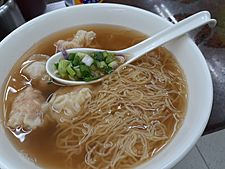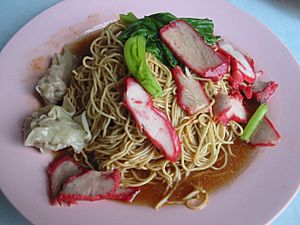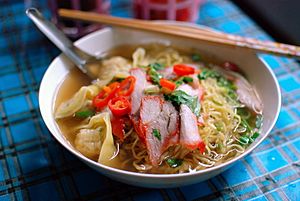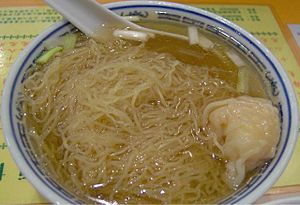Wonton noodles facts for kids

A bowl of wonton noodle soup
|
|
| Type | Noodles |
|---|---|
| Course | Main course |
| Place of origin | China |
| Region or state | Guangdong, Hong Kong, Indonesia, Malaysia, Singapore, Philippines and Thailand |
| Serving temperature | Hot |
| Main ingredients | flour, egg, pork, shrimp |
| Wonton noodles | |||||||||||||
|---|---|---|---|---|---|---|---|---|---|---|---|---|---|
| Traditional Chinese | 雲吞麵 | ||||||||||||
| Simplified Chinese | 云吞面 | ||||||||||||
| Literal meaning | Wonton noodles | ||||||||||||
|
|||||||||||||
Wonton noodles (Chinese: 雲吞麵; Cantonese Yale: wàhn tān mihn) is a yummy noodle dish. It comes from a type of Chinese cooking called Cantonese. People gave it the name húntún way back in the Tang Dynasty (618-907 CE).
This dish is super popular in places like Southern China, Hong Kong, Indonesia, Malaysia, Singapore, and Thailand. It usually has egg noodles in a warm, tasty broth. It's often topped with green leafy vegetables and special dumplings called wontons. A common green vegetable used is gai-lan, also known as Chinese broccoli. Sometimes, another type of dumpling called shui jiao is used instead of wontons.
Wontons are often filled with prawns, chicken, or pork. Some chefs also add spring onions, mushrooms, or black fungus. In Indonesia, especially in certain areas, wonton noodles are called mie pangsit.
Contents
Wonton Noodles in Hong Kong and Guangzhou
In Guangzhou and Hong Kong, wonton noodles are usually served in a hot soup. They come with shrimp wontons and green leafy vegetables. There are many ways to enjoy this dish. Sometimes, the soup and wontons are in separate bowls. The noodles might be served almost dry, with a sauce, or you can dip them in the soup.
This dish has four special things that make it unique:
- First, the wontons are mostly filled with prawns. They have only a little bit of minced pork, or sometimes no pork at all. Traditionally, wontons are 70% shrimp and 30% pork.
- Second, the noodles are fresh and thin. They are cooked just right, so they are a bit firm to bite. This is called al dente. They also don't have a strong egg noodle smell.
- Third, the soup is light brown and very hot. It's made from dried flounder, which is a type of fish.
- Lastly, garlic chives are used as a topping. These special touches make the dish feel crunchy and taste amazing.
To make sure the noodles are perfect, chefs follow a careful cooking process. First, the wontons are cooked and placed in the bowl. Then, the noodles are quickly boiled for only 10 seconds. After that, they are rinsed in cold water and put into the serving bowl. Finally, hot soup is poured over the wontons and noodles. The soup tastes good but isn't so strong that it hides the delicate flavors of the wontons and noodles.
When the dish is served, the spoon is placed at the bottom of the bowl. The wontons go above the spoon, and the noodles are on top. This is important! If the noodles stay in the soup for too long, they can get too soft. The best wonton noodle shops always do this.
Even though "wonton noodle" usually means soup, you can also get it "damp." This is like lo mein, where the wontons are placed on a big pile of noodles without much soup.
Malaysian Wonton Noodle Dishes

Malaysia has many different kinds of wonton noodles. Each state, like Johor, Pahang, Perak, Penang, Sarawak, and Selangor, has its own version. The Malaysian style is different from the original. It often has slices of char siu (barbecued pork) added.
In Malaysia, the soup and wontons can be in separate bowls. The noodles are often served dry with oyster sauce and chopped spring onions. Some places even add deep-fried wontons to the dry versions.
The Hong Kong style, with lots of soup, can be found in Malaysian Cantonese noodle shops. In Malacca, wontons are put with the noodles, and you can order wonton soup separately. The Malacca version is usually spicier because it uses a special chili sauce.
You can also find vegetarian wonton mee in Malaysia. Instead of pork for char siu, they use wheat gluten.
Philippine Wonton Noodle Dishes
There are three main types of wonton noodle dishes in the Philippines.
- One is mami. This is a noodle soup with egg noodles, wontons, and different vegetables in a hot broth. The name mami means "pork noodles" in Chinese.
- Another type is pancit molo. It's like mami, but the noodles are actually the wonton wrappers themselves.
- The third type is stir-fried egg noodles. You can buy these from street vendors. The noodles are stir-fried with mung bean sprouts and vegetables. They are flavored with different sauces and topped with wontons.
Singaporean Wonton Noodles
Singaporean wonton noodles include noodles, green leafy vegetables (like cai-xin), barbecued pork (char siu), and small wonton dumplings. It can be served dry or in soup, but the dry version is more popular. If it's dry, the wontons come in a separate bowl of soup.
Some stalls serve shui jiao (prawn dumplings). The original Hong Kong version is also available in Cantonese restaurants. Sometimes, fried wontons (deep-fried in oil) are served instead of boiled ones. The Singaporean and Malaysian versions are similar. However, the Singaporean one uses less soy sauce and often comes with spicy chili ketchup.
Thai Wonton Noodles

Wonton noodles (Thai: บะหมี่เกี๊ยว; bami kiao) are also very popular in Thailand. Just like in Malaysia and Singapore, people often order them with barbecued pork. This dish is then called bami mu daeng kiao (Thai: บะหมี่หมูแดงเกี๊ยว), where mu daeng means "red pork."
In Thailand, people often add extra flavors to their noodle soups. They might add chilies in vinegar, dried chili flakes, sugar, and fish sauce to make it taste just right. The dish is mostly eaten as a soup. But it can also be served dry with the broth on the side.
Vietnamese Wonton Noodles
Súp mì or mì for short is a Chinese-Vietnamese noodle soup. Chinese immigrants brought it to Vietnam. Mì hoành thánh is the Vietnamese version of wonton noodle soup. The noodles can be served with the soup or with the soup on the side. Common ingredients include yellow wheat (egg) noodles with a pork broth, ground pork, chives, and different meats and toppings.
See also
 In Spanish: Wanton mee para niños
In Spanish: Wanton mee para niños


